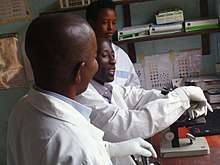Health in Burundi
Following independence, the World Health Organization (WHO) assisted in the organization of public health services and the training of sanitarians and public health nurses for Burundi. Students from Burundi received medical training at universities in France and in the Democratic Republic of the Congo. WHO coordinated all public health programs and helped in campaigns against smallpox, tuberculosis, and malaria.

WHO, the UN Food and Agriculture Organization, and UNICEF also provided aid for nutrition and maternal and child health programs. Following the assassination of the president of Burundi in 1993, widespread violence involving tribal groups uprooted many of Burundi’s people. Approximately 683,000 people fled to neighbouring countries, rural villages, or towns where sanitation is poor.
Health infrastructure
In 2004, there were an estimated 5 doctors, 28 nurses and 1 pharmacist per 100,000 people. Total health care expenditures were estimated at 3.7% of GDP. Burundi had the lowest consumption of antibiotics of any country in the world in 2015 with a rate of 4.4 defined daily doses per 1,000 inhabitants per day.[1]
Health status
Life expectancy
The average life expectancy in 2005 was estimated at 50 years, up from 42 years in 2000.
Diseases
Outbreaks of Group A meningitis are occurring in Burundi. There have been over 2,500 cases of meningitis. Trypanosomiasis (sleeping sickness), borne by the tsetse fly, is a problem in the Ruvuvu River Valley. Malaria and schistosomiasis (bilharziasis) are common along the Ruzizi River.
The HIV/AIDS prevalence was 6.00 per 100 adults in 2003. As of 2004, there were approximately 250,000 people living with HIV/AIDS in Burundi. There were an estimated 25,000 deaths from AIDS in 2003.
Malnutrition
Intake of animal protein and fat is inadequate and almost all diseases associated with malnutrition are found in Burundi.
Maternal and child healthcare
The 2010 maternal mortality rate per 100,000 births for Burundi is 970. This is compared with 569.6 in 2008 and 711.6 in 1990. The under 5 mortality rate, per 1,000 births is 168 and the neonatal mortality as a percentage of under 5's mortality is 26. In Burundi the number of midwives per 1,000 live births is 4 and the lifetime risk of death for pregnant women 1 in 25.[2]
9 percent of married women (ages 15 to 49) practised contraception. In 1999, Burundi immunized children up to one year of age as follows: diphtheria, pertussis, and tetanus, 74 percent and measles, 75 percent. Approximately 38 percent of children under five years old were considered to be malnourished.
See also
- Abortion in Burundi
References
- "UK antibiotic consumption twice that of the Netherlands, WHO report finds". Pharmaceutical Journal. 14 November 2018. Retrieved 22 December 2018.
- "The State Of The World's Midwifery". United Nations Population Fund. Retrieved 1 August 2011.